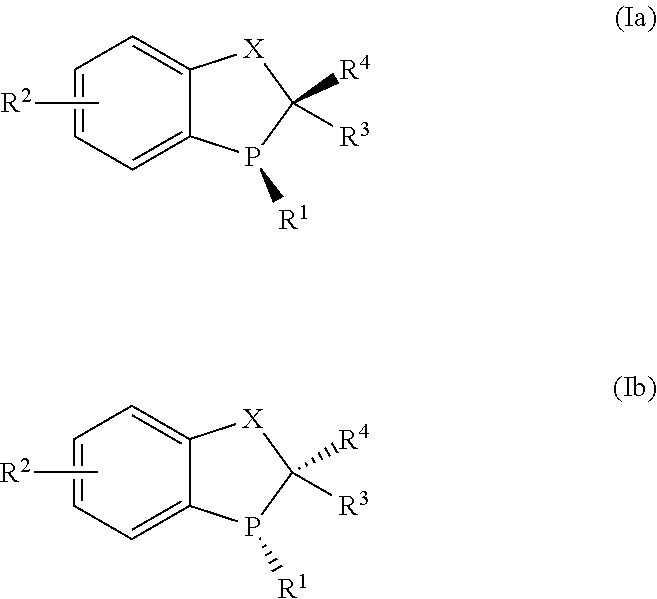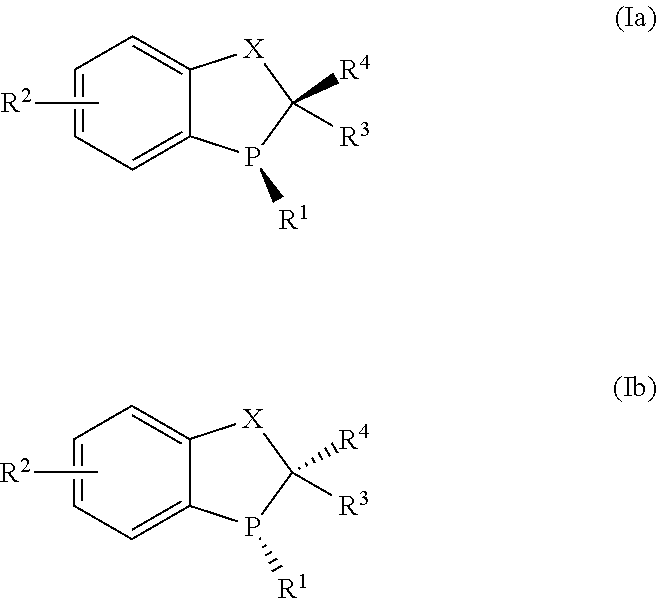Novel chiral phosphorus ligands
a phosphorus ligand and chiral technology, applied in the field of new chiral phosphorus ligands, to achieve the effect of high enantioselectivity, excellent reactivity and enantioselectivity in asymmetric hydrogenation
- Summary
- Abstract
- Description
- Claims
- Application Information
AI Technical Summary
Benefits of technology
Problems solved by technology
Method used
Image
Examples
examples 1-4
[0107]Examples 1-4 describe the preparation of (R)-3-tert-butyl-2,3-dihydrobenzo[d][1,3]oxaphosphol-4-ol oxide ((R)-3) as depicted below:
example 1
Preparation of tert-butyl(2,6-dimethoxyphenyl)(methyl)phosphine oxide (1)
[0108]To a solution of dichloromethylphosphine (6.61 g, 57 mmol, 1.0 equiv.) in THF (50 mL) was added dropwise 1.0 M tBuMgCl (57 mL, 57 mmol, 1.0 equiv.) over 1 h while controlling the reaction temperature tBuMgCl was added dropwise the mixture of in situ generated 2,6-dimethoxyphenyllithium made above over 0.5 h while controlling the reaction temperature 2O2 over 10 min at 0° C. and the mixture was further stirred at 25° C. for 0.5 h, and then quenched with addition of 2 N HCl (300 mL) and dichloromethane (300 mL). The dichloromethane layer was washed with brine (300 mL), dried over magnesium sulfate, and purified by column chromatography (eluents: EtOAc to EtOAc / MeOH 4 / 1; monitored at 290 nm) to provide 1 as a thick oil (9.5 g, 37 mmol, 65%). 1: 1HNMR (400 MHz, CDCl3): δ=7.41 (m, 1H), 6.60 (dd, J=8.4, 3.8 Hz, 2H), 3.84 (s, 6H), 1.83 (d, J=13.2 Hz, 3H), 1.18 (d, J=15.4 Hz, 9H); 31PNMR (162 MHz, CDCl3): δ=51.4;...
example 2
Preparation of tert-butyl(2,6-dimethoxyphenyl)(iodomethyl)phosphine (2)
[0109]To a solution of 1 (7.4 g, 28.9 mmol, 1 equiv.) and TMEDA (6.50 mL, 43 mmol, 1.5 equiv.) in THF (40 mL) at −78° C. was added 2.5 M BuLi in hexanes (13.9 mL, 35 mmol, 1.2 equiv.) over 10 min. The resulting mixture was stirred at −78° C. for 1 h. To the mixture at −78° C. was added iodine (11.0 g, 43 mmol, 1.5 equiv.) in THF (20 mL) while controlling the temperature 3 solution (100 mL) and dichloromethane (100 mL). The dichloromethane layer was washed with brine (100 mL), dried over sodium sulfate, concentrated, and purified by silica gel column chromatography (eluents: EtOAc to EtOAc / MeOH 10 / 1; monitored at 290 nm) to provide 2 as a thick oil (8.8 g, 23.0 mmol, 80%). 1HNMR (400 MHz, CDCl3): δ=7.40 (t, J=8.4 Hz, 1H), 6.56 (dd, J=8.4, 4.0 Hz, 2H), 3.80 (s, 6H), 3.79 (m, 1H), 3.34 (dd, J=11.2, 8.3 Hz, 1H), 1.18 (d, J=15.6 Hz, 9H); 31PNMR (162 MHz, CDCl3): δ=50.4; 13CNMR (100 MHz, CDCl3): δ=163.2, 134.2, 104.9 (...
PUM
| Property | Measurement | Unit |
|---|---|---|
| Fraction | aaaaa | aaaaa |
| Fraction | aaaaa | aaaaa |
| Fraction | aaaaa | aaaaa |
Abstract
Description
Claims
Application Information
 Login to View More
Login to View More - R&D
- Intellectual Property
- Life Sciences
- Materials
- Tech Scout
- Unparalleled Data Quality
- Higher Quality Content
- 60% Fewer Hallucinations
Browse by: Latest US Patents, China's latest patents, Technical Efficacy Thesaurus, Application Domain, Technology Topic, Popular Technical Reports.
© 2025 PatSnap. All rights reserved.Legal|Privacy policy|Modern Slavery Act Transparency Statement|Sitemap|About US| Contact US: help@patsnap.com



